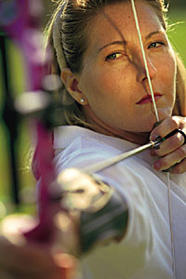
Seeing Their Way to the Top
Legend has it that baseball great Ted Williams could see the seams on a baseball coming toward him at 95 mph and read a record label spinning on a turntable. The New York Yankees’ Jason Giambi has said he recognizes the pitch the moment the ball leaves the pitcher’s hand. Most hitters, players estimate, pick up the pitch at a distance of 30 feet, about halfway from mound to plate. Today’s top athletes incorporate eye conditioning exercises into their workouts to gain an edge over the competition. In recent years, sports vision therapy has grown in popularity. “I spend hours and hours working on my bow and practicing. My bow’s important, my arrow’s important, my eyesight is just as important,” said Vic Wunderle, an Olympic medalist for the U.S. in archery.
Sports vision therapy exercises are designed to make the eyes work together better, track balls moving at incredible speeds, quicken brain response time, gauge depth and distance, improve peripheral vision, and switch focus more rapidly. Optometrists use techniques that include beads on strings, prisms, trampolines, balance boards, red lenses, green lenses. “We think of 20/20 as the ultimate vision, but athletes at the elite level often have 20/10,” said Dr. Graham Erickson, an optometrist and author of Sports Vision: Vision Care for the Enhancement of Sports Performance. “They can see at 20 ft. what the average person can see at 10.”
Dr. Hal Breedlove, past President of the American Optometric Association’s Sports Vision Section, is careful to point out that he’s not strengthening eye muscles, he’s strengthening control. As part of his exercise program, he gives players glasses with prisms. Prisms add stress,” he said. They “throw the visual system off and you have to learn to compensate. [The exercise] improves the body’s flexibility.”
Dr. Elise Brisco, an optometrist who’s worked with the Anaheim Mighty Ducks, used strobe lights, bean bags, balance boards and trampolines. “Your vision guides your hands, your legs, your balance, your shifting of weight,” she said. “When the puck is moving so fast, you need to make a continual dynamic adjustment.”
So she might have the player stand on a balance board, and as he moved forward or backward, as if surfing, she’d turn on a strobe light and throw a ball at him. “With the strobe light, they didn’t see the entire pathway,” said Brisco. “So they had to fill in the gaps with their mind’s eye. That’s visualization. When we would turn the lights on, they’d see the entire pathway of the target, and it would seem slower.”
As sports become faster and more competitive, sports vision therapy will continue to grow. Although the goal is highly individualized for each athlete, one common goal is to ensure that all the visual processes are making a positive contribution to the athlete’s performance and not creating a distraction.
Excerpted from an ABC News story by Nancy Ramsey
***M&S Technologies Smart System 20/20 Computerized Vision Testing System was designed for the forward-thinking eye care professional. The rich features and innovations of the Smart System, combined with attentive customer service and expert technical support, are the reason we’ve been the tried-and-true choice in computerized vision testing for over 20 years.***
Have a thought about this article? Contact Us and let us know.